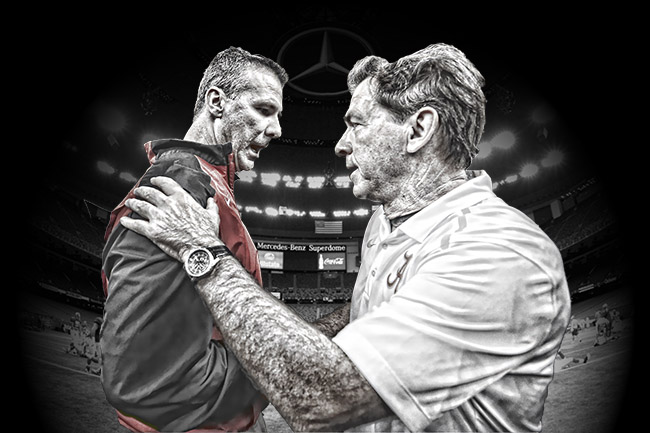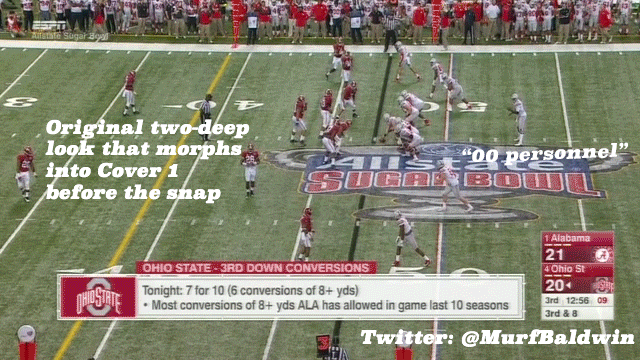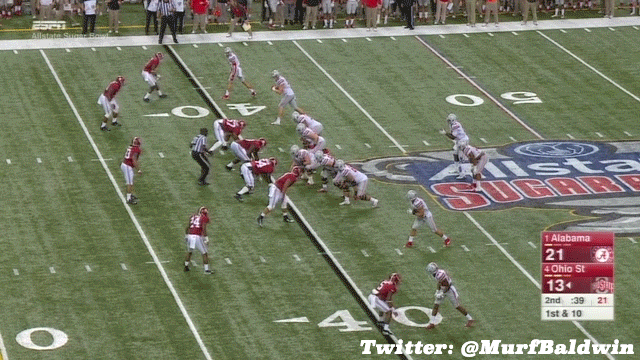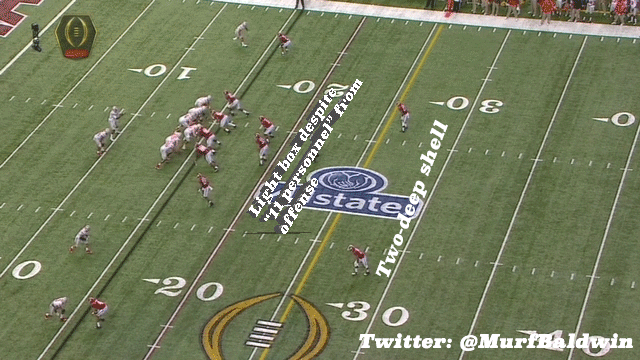Film Study: Ohio State's win over Alabama was nowhere near a fluke
“Words can’t describe it,” Ohio State University star quarterback Cardale Jones said after his team’s 42-35 victory over the University of Alabama in the Sugar Bowl.
“We took down the big, bad SEC.”
You can bet your bottom dollar that this sentiment was echoed all over the country with the success the other “Power Five” conferences had over the Southeastern Conference. Auburn, Mississippi State. Ole Miss and Louisiana State University all took losses in their respective bowl games.
While it should be pointed out that the University of Georgia, Arkansas, Texas A&M, South Carolina and Missouri did its conference proud with their wins over Louisville, Texas, West Virginia, Miami and Minnesota, respectively.
But it’s Alabama’s loss that undoubtedly sent shockwaves throughout the southern part of the United States as just about anyone with an opinion believed it was a foregone conclusion that the Tide would find themselves competing for the College Football Playoff Championship in Arlington, TX., on Jan. 12th.
But should it have?
This whole conference supremacy thing has created an overabundance of confidence from SEC fans in regard to who is actually quality competition. While for the most part there are teams that would struggle to compete inside the conference, there are plenty of teams that would find no problems navigating an SEC schedule.
And I said it before this tilt was played in my preview article entitled: Complete scheme & tactical breakdown for Alabama vs. Ohio State.
OSU is one of the most well-schemed teams in the nation that appears to execute on an SEC-like level; Alabama is the most well-schemed team that is the king of the SEC.
With the two very best coaches in the nation — with apologies to Florida State’s Jimbo Fisher — receiving nearly a month to gameplan for one another, one can only imagine the wrinkles that will be unaccounted for…
That’s the thing, there’s plenty of parity in college football as great coaches continue to take jobs all over the country. It’s about schemes, recruiting and player development; teams must be judged on a case-by-case basis.
My case for OSU began and ended with head coach Urban Meyer — whom I labeled as, perhaps, the preeminent offensive mind in all of college football.
Some coaches just get it, none more than Meyer; if you have a weakness he will exploit it.
It was widely known that Bama has struggled to generate the type of play in the secondary that we’ve come to know from a Nick Saban-led team. Corners Eddie Jackson, Cyrus Jones and Brad Sylve have struggled, predominantly, to defend the pass the further it goes downfield — despite stellar play from superstar safety Landon Collins and, at times, fellow safety Nick Perry.
You had to believe the game plan from OSU would involve stretching the field vertically and forcing Alabama to go to more of an area look with its coverage shell.
Receiver Devin Smith is about as effective as it gets in the vertical game, and when combined with quarterback Cardale Jones — who has the strongest arm I’ve seen since former LSU QB Jamarcus Russell — you had the makings of a complete nightmare for Saban and the Tide secondary.
Here he takes the top off the defense, which jumped into Cover 1 after initially providing a Cover 2 look. This meant that it was man coverage across the board and the single-high safety would have a lot of landscape to cover.
Alabama is at its best when Collins is able to act as a pseudo linebacker on base down and distances as he’s the best tackler in space outside of inside linebacker Reggie Ragland. When the Tide can jump in an odd-front alignment, come downhill and thump, the game slows down for them from a tactical standpoint.
Furthermore, when Bama can go to its plethora of fabricated-pressure schemes it can dictate to the offense; Saban’s scheme is all about forcing the offense into looks that are favorable for his personnel.
However, when the Tide have to go more of a hybrid look, alternating from a 4-3-based alignment and a multitude of sub-packages, the game seems to speed up, compromising the most basic of aspects: tackling, tracking the ball in the air and assignment football.
The threat of 9’s, Posts, Digs, and Deep Comebacks forced the Tide into a Cover 2 shell and opened up the edge-bending run game for the Buckeyes. Additionally, when you allow a rocket-arm QB — with the prerequisite accuracy — the opportunity to find voids in your defense, chances are he will.
The fact that the Tide had to be wary of the big play through the air, Meyer (and offensive coordinator Tom Herman) made sure to send all targets out to explosive depth which, in turn, allowed for up-the-gut scrambles for Jones — who proved to be a more-than-capable runner in a scheme that has seen some serious athletes (most notably Braxton Miller and Tim Tebow).
In fact, the 6’5″, 250-pound Jones manufactured quite a few first downs with his legs, against a normally stingy Tide defense, finishing with some serious physicality in some instances.
Case in point…But these type of plays can be put into the unaccounted for category as they are almost indefensible.
But what was mostly indefensible was OSU’s explosive running back Ezekiel Elliott and his penchant for generating second- and third-level jaunts. His 230 yards on just 20 attempts were back-breaking in every sense of the word.
While he’s known for his explosive speed, he sent a message on shorter runs by punishing would-be tacklers, as well.
He was simply the best player on the field.
Look at how he made mincemeat of the Tide defense on this sweep. It must be noted that Ragland was injured and missed a significant portion of the game; his athleticism was sorely missed.
It’s time for Saban to have a serious look at his secondary next season. While it’s filled with 5-star athletes, it has been a complete disappointment since the departure of Dee Milliner in 2013. Freshmen Tony Brown and Marlon Humphrey — along with the incoming Minkah Fitzpatrick — will be counted on to bring the Tide back to their glory days.
The ability to leave corners on an island is a necessity for a Saban-led defense.
Criticism Of Lane Kiffin’s Play-Calling
Without a doubt, Alabama’s offense has shined this year under much-maligned offensive coordinator Lane Kiffin. He’s effectively shed a lot of the grime that was on him from failed stints at the University of Southern California and with the Oakland Raiders.
Saban, in his own words, wanted to open up the offense as he felt somewhat constricted under previous coordinators Jim McElwain and Doug Nussmeier — both of whom brought more of a physical rushing attack.
Saban proved to be genius, as always, as Kiffin took a first-time starter in fifth-year senior Blake Sims and produced the greatest passing offense in Alabama history. But I could see it coming during the year, as Kiffin continuously fell in love with the pass a little too much.
Although there’s more than one way to skin a cat, you can’t argue that Bama has been built on the strength of some of the best running backs in modern history — and this year’s staple of backs are no different than year’s past.
Between T.J. Yeldon and Derrick Henry there’s no reason to believe that Bama can’t find sustainable success on the ground in any given game. And although Yeldon came into the game battling injury, Henry looked every bit as explosive as Elliott and OSU had very little answers for him.
But for some odd reason he only received 13 carries despite generating 95 yards on them. While Henry is not the type of physical runner we’re used to seeing from Bama, his penchant for executing edge-bending runs in quite uncanny.
For a game that was never out of hand for Alabama, you would think that the Saban-Kiffin duo would have sensed this and rode him until the well dried up.
But instead, they consistently put the ball into the hands of Sims which played into Ohio State defensive coordinator Luke Fickell’s gameplan.
In retrospect, they should’ve made the Buckeyes respect the run game until the coverage loosened up. Moving forward, you can expect the pair to rectify this and not go into any game leaning one way or another.
However, the Tide may need to find a more physical complementary back moving forward who can wear down defenses when necessary. (I’ll have more on that in a forthcoming article.)
This is not to say that the Tide didn’t do anything right in this game. They did put up 35 points — which would usually win a game — and collapsed the pocket quite a bit on Jones. Although they may lose three of their best players, Collins, Yeldon and receiver Amari Cooper, there’s plenty of talent in tow and on the way.
This game was an exciting tilt between two evenly matched squads with the premier coaches in their respective fields of expertise; when two teams possess elite personal, schemes and coaching staffs, the game usually comes down to which squad executes in an effective manner.
Hats off to you, Ohio State and Coach Meyer. But you will be seeing plenty of Alabama in your future as the Tide aren’t going anywhere as long as that Saban guy is in town.
And that’s what big-time college football is all about: parity. It’s time to start respecting these other conference, SEC fans.
Especially the Big 10.




